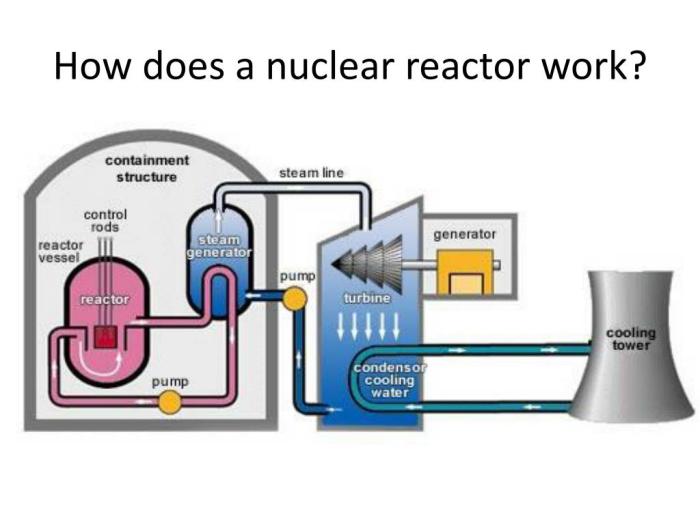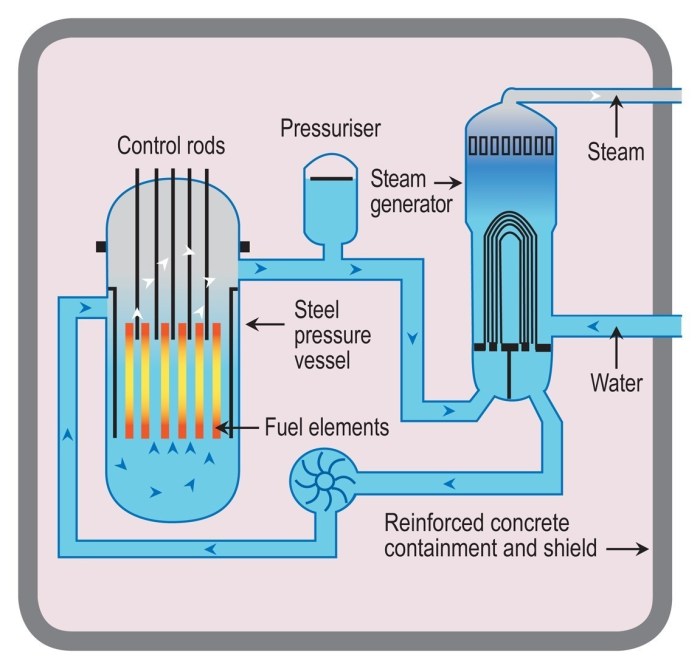How does a nuclear reactor work? Embark on a journey to unravel the complexities of nuclear energy, from the fundamental principles of nuclear fission to the intricate designs and safety measures that govern these powerful machines.
Nuclear reactors are marvels of engineering, harnessing the energy released from nuclear reactions to generate electricity, power research, and drive medical advancements. This exploration will delve into the inner workings of nuclear reactors, shedding light on their components, processes, and the critical role they play in shaping our energy landscape.
Nuclear Fission

Nuclear fission is a process that involves the splitting of an atomic nucleus into two or more smaller nuclei, accompanied by the release of a great amount of energy.
In a nuclear reactor, the fissionable material used is typically uranium-235 or plutonium-239. When a neutron is absorbed by a uranium-235 nucleus, it becomes unstable and splits into two smaller nuclei, such as krypton-92 and barium-141. This process releases a significant amount of energy in the form of heat and radiation.
Chain Reaction
The fission process in a nuclear reactor is sustained by a chain reaction. In this process, the neutrons released during the fission of one nucleus can go on to cause fission in other uranium-235 nuclei, leading to a continuous release of energy.
To control the chain reaction, control rods made of materials such as cadmium or boron are inserted into the reactor core. These rods absorb neutrons, slowing down or stopping the chain reaction.
Reactor Design

A nuclear reactor is a device that controls the fission reaction to produce electricity. It consists of several key components that work together to harness the energy released during fission.
Reactor Core
The reactor core is the heart of the reactor, where the fission reaction takes place. It contains fuel rods made of uranium or plutonium, arranged in a lattice structure to allow for efficient neutron moderation and heat transfer. The fuel rods are enclosed in a protective cladding material to prevent the release of radioactive material into the coolant.
Moderator
The moderator is a material that slows down the neutrons produced during fission to make them more likely to interact with other uranium atoms and sustain the chain reaction. Common moderators include ordinary water, heavy water, and graphite.
Control Rods
Control rods are made of neutron-absorbing materials, such as boron or cadmium, and are inserted into the reactor core to control the rate of fission. By adjusting the position of the control rods, the operator can regulate the power output of the reactor.
Cooling System
The cooling system removes the heat generated by the fission reaction to prevent the reactor from overheating. Coolants used in nuclear reactors include water, heavy water, liquid sodium, and helium gas. The coolant circulates through the reactor core, absorbing heat from the fuel rods and transferring it to a heat exchanger, where it is converted into steam to drive a turbine generator.
Types of Nuclear Reactor Designs
There are various types of nuclear reactor designs, each with its own advantages and disadvantages. Some common types include:
- Pressurized Water Reactor (PWR): Uses ordinary water as both moderator and coolant, operating at high pressure to prevent boiling.
- Boiling Water Reactor (BWR): Also uses ordinary water, but allows it to boil in the reactor core, producing steam directly.
- Heavy Water Reactor (HWR): Utilizes heavy water as both moderator and coolant, providing more efficient neutron moderation.
- Gas-Cooled Reactor (GCR): Uses a gas, such as helium or carbon dioxide, as a coolant and graphite as a moderator.
- Liquid Metal-Cooled Reactor (LMCR): Employs liquid sodium as a coolant, offering high heat transfer efficiency.
Energy Production
Nuclear reactors generate energy through the process of nuclear fission, where atoms are split apart to release energy. This energy is in the form of heat, which is then used to convert water into steam. The steam drives a turbine, which generates electricity.
Heat Generation
In a nuclear reactor, nuclear fission occurs within the fuel rods. The fuel rods contain uranium or plutonium atoms, which are bombarded with neutrons. This causes the atoms to split apart, releasing a great amount of energy in the form of heat.
The heat is then transferred to a coolant, which is usually water.
Converting Heat to Electricity
The heated coolant is then pumped through a heat exchanger, where it transfers its heat to water in a separate loop. The water in the separate loop is converted into steam, which is then used to drive a turbine. The turbine is connected to a generator, which converts the mechanical energy of the turbine into electrical energy.
Efficiency and Output
Nuclear reactors are very efficient at producing electricity. They can operate continuously for long periods of time, and they produce a large amount of electricity relative to the amount of fuel they consume. The output of a nuclear reactor is measured in megawatts (MW) or gigawatts (GW).
A typical nuclear reactor can produce around 1,000 MW of electricity, which is enough to power a city of around 1 million people.
Fuel Management: How Does A Nuclear Reactor Work
Nuclear fuel management encompasses the handling and processing of nuclear fuel throughout its lifecycle. It involves loading, monitoring, and replacing fuel assemblies within the reactor core. Spent fuel management addresses the safe storage and disposal of irradiated fuel after it has been removed from the reactor.
Fuel Loading and Monitoring
Fresh nuclear fuel assemblies are loaded into the reactor core according to a predetermined pattern. The fuel assemblies are composed of fuel rods containing enriched uranium or plutonium. The reactor is designed to allow for continuous monitoring of fuel performance, including temperature, neutron flux, and fission product levels.
This monitoring helps ensure safe and efficient reactor operation.
Fuel Replacement, How does a nuclear reactor work
As fuel is consumed in the reactor, it gradually loses its reactivity. To maintain a sustained chain reaction, spent fuel assemblies are periodically replaced with fresh ones. The replacement process involves shutting down the reactor, removing the spent fuel assemblies, and inserting new ones.
The spent fuel is then transferred to a spent fuel pool for cooling and storage.
Spent Fuel Management
Spent nuclear fuel contains radioactive waste products that must be managed safely. One common approach is to store the spent fuel in a deep geological repository, where it is isolated from the environment for thousands of years. Research is also ongoing to develop advanced fuel cycles that can reduce the amount of waste produced.
Nuclear Waste Disposal
The long-term disposal of nuclear waste remains a global challenge. The primary focus is on developing a deep geological repository that can safely isolate the waste from the environment for extended periods. The disposal site should be geologically stable and have a low risk of human intrusion or natural disasters.
Safety and Regulation
Nuclear reactors are designed with multiple layers of safety measures to prevent and mitigate accidents. These include physical barriers, redundant systems, and emergency response plans.
Regulatory agencies play a crucial role in ensuring reactor safety. They establish and enforce regulations, conduct inspections, and review safety assessments.
Nuclear Accidents
Nuclear accidents are rare, but they can have severe consequences. The most well-known accidents include Chernobyl in 1986 and Fukushima Daiichi in 2011. These accidents highlight the importance of safety measures and regulatory oversight.
Nuclear power plants are designed to prevent and mitigate accidents through multiple layers of safety systems, including:
- Containment structures:Massive concrete and steel structures that enclose the reactor core and prevent the release of radioactive material in the event of an accident.
- Emergency core cooling systems:Systems that automatically inject water into the reactor core to prevent it from overheating and melting.
- Backup power systems:Emergency generators and batteries that provide power to safety systems in the event of a loss of normal power.
Regulatory agencies play a crucial role in ensuring reactor safety. They establish and enforce regulations, conduct inspections, and review safety assessments. In the United States, the Nuclear Regulatory Commission (NRC) is responsible for regulating nuclear power plants.
Nuclear accidents are rare, but they can have severe consequences. The most well-known accidents include Chernobyl in 1986 and Fukushima Daiichi in 2011. These accidents highlight the importance of safety measures and regulatory oversight.
Applications
Nuclear reactors have a wide range of applications beyond electricity generation. They are used in research, medicine, and other fields.
Research
Nuclear reactors are used in research to study the properties of materials and to develop new technologies. They are also used to produce isotopes for medical and industrial purposes.
Medical Uses
Nuclear reactors are used to produce isotopes that are used in medical imaging and treatment. For example, the isotope iodine-131 is used to treat thyroid cancer.
Electricity Generation
Nuclear reactors are a major source of electricity around the world. They provide a reliable and relatively low-carbon source of energy.
Advantages of Nuclear Power
- Nuclear power is a reliable source of energy.
- Nuclear power plants do not produce greenhouse gases.
- Nuclear power is a relatively inexpensive source of energy.
Disadvantages of Nuclear Power
- Nuclear power plants can be expensive to build.
- Nuclear power plants produce radioactive waste.
- Nuclear power plants can be a target for terrorist attacks.
Examples of Nuclear Power Plants
There are hundreds of nuclear power plants in operation around the world. Some of the largest nuclear power plants include:
- Bruce Nuclear Generating Station (Canada)
- Fukushima Daiichi Nuclear Power Plant (Japan)
- Zaporizhzhia Nuclear Power Plant (Ukraine)
Epilogue

In conclusion, nuclear reactors stand as a testament to human ingenuity, offering a complex yet efficient means of energy production. While concerns regarding safety and waste management persist, ongoing research and advancements strive to address these challenges, ensuring the responsible and sustainable utilization of nuclear power.
FAQs
What is nuclear fission?
Nuclear fission is a process where an atomic nucleus is split into smaller nuclei, releasing vast amounts of energy.
How do nuclear reactors generate electricity?
Heat generated from nuclear fission is used to create steam, which drives turbines connected to electricity generators.
Are nuclear reactors safe?
Nuclear reactors are designed with multiple safety systems to prevent and mitigate accidents, and are subject to rigorous regulatory oversight.